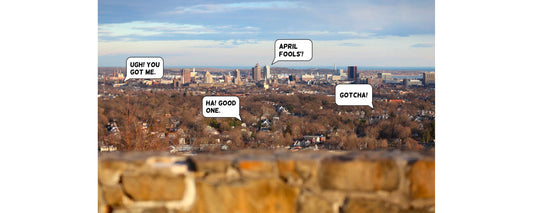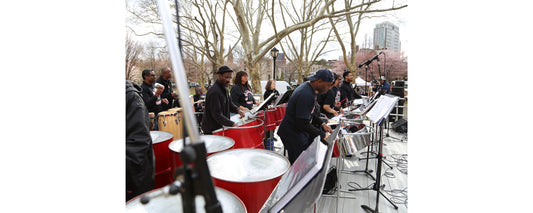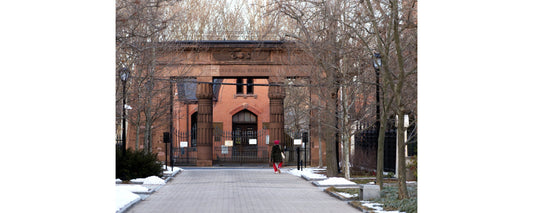To see all 29 images published with this story, check out the email version.
Its campus is a quilt of manicured green expanses, charming New England architecture and elegant stone courtyards threaded with crisscrossing paths and dramatic stairways. Its structures are named for donors or past leaders, with dedicated buildings for sciences, arts and athletics. It’s more than 300 years old and has its own archivist. It’s considered to be among the finest of its kind.
It’s not Yale. It’s Hopkins, an independent coed day school serving grades 7 through 12, and, in fact, it’s decades older than Yale. Also, unlike Yale, it was founded in New Haven, right on the Green.
Thom Peters, the aforementioned archivist (who also teaches), is able to conjure a typical scene from those early days. In the year 1660, gathered inside a tiny one-room schoolhouse situated between the colonial jail and courthouse, the school’s first students, all boys, would have been “sitting on benches with hornbooks, practicing their Latin, translating, then coming up to the desk of the schoolmaster to show them what they translated—to my mind, not terribly exciting, but efficient I guess in preparing students for university work, which meant Latin [and] Greek.”
Latin is still offered at Hopkins today, and, of course, the school still aims to rigorously prepare its students for college. But that’s pretty much where the similarities end. Located on a Westville hill tall enough to overlook the city, Hopkins circa 2019 is a place where “a kid can go deep in a particular area—as deep as he or she or they would like to go—but also… be as broad and wide and balanced as they’d like to be,” head of school Kai Bynum says. In addition to the contemporary foundational subjects and tracks you would expect, this year there are credited classes in acting, computer programming, fencing, forensic science, Native American literature, poetry, public speaking, psychology, video production, weight training, yoga. That’s not even getting into the offerings available via the Malone Schools Online Network, or MSON, which currently allows Hopkins students to take courses led by teachers at 22 independent schools around the country (and allows those schools’ students to take courses based at Hopkins). MSON’s 2019-2020 catalog includes classes on biomedical ethics, food writing, multivariable calculus and macro- and microeconomics. Meanwhile, through the Hopkins Authentic Research Program in Science (HARPS), rising seniors who’ve met certain requirements can intern with university science labs—including, Bynum notes, at Yale.
During a recent visit, teacher Mike Calderone’s Theater Ensemble class may as well have been a laboratory for engaged pedagogy. Dressed in a hoodie because it was Spirit Week—the theme that day entailed teachers and students swapping styles—Calderone was as much a conductor as a director. Calling, cuing and motioning a dozen or so kids through a fast-paced scene in an original play they’re preparing to stage, his voice and hands hardly ever took a break. Whenever he could take a moment and simply observe, he was beaming, and the kids, between performing their lines and rushing to hit their marks, were beaming right back. There was laughter, so much laughter, but also a kinetic air of commitment. Calderone was in, and so were the kids.
Earlier in the day, teacher Tim Phipps added an element of activity and fun to his AP history lesson on the Articles of Confederation, asking juniors and seniors to come up to the whiteboard and use period-specific words and phrases to create a reverse acrostic out of the word “CONFEDERATION.” (The first O, for example, became “Olive Branch Petition,” which refers to a last-ditch effort by American colonists to avoid war with England; the second became “Ordinance of 1784,” a law that created the framework for the addition of new states beyond the original 13.) Later, students in an architecture course listened as a classmate took them through her proposal for an annex to the school cafe (not to be confused with its cafeteria), then offered critical questions when prompted by teacher Derek Byron. Later still, math teacher Adam Sperling explained bell curves, prefacing the lesson by telling his students that once they understood the concept, they might not be so eager to request that their tests be graded on a curve.
During the middle of the day, on playing fields around campus, junior schoolers—seventh- and eighth-graders—were fulfilling that day’s athletics requirement by playing soccer, though the junior school football players were having a team practice instead. Over in the Walter Camp Athletic Center—the “Father of Football” was a Hopkins alum—the cross country team was getting ready for a run. One boy had a cavernous basketball court all to himself, unless you count the machine under the hoop that was passing the ball back.
There was plenty of space almost everywhere. Throughout the day I observed—including, of course, during the times between classes, when the halls of my own high school were crammed tighter than a clown car—the only place that felt crowded was the cafeteria during lunch. And that makes even more sense than you’d think, because, aside from the truism that teenagers love to eat, the food was really good. (I opted for a trip to the salad bar with a side of perfectly fried potato wedges.) The school says on its website that “our skilled chefs make nearly every meal from scratch,” touting the use of whole, unprocessed ingredients.
Schoolwide, about 60% of Hopkins students are from the Greater New Haven area, which means some 40% attend from farther afield. “Our geographic diversity is deliberate,” Bynum says, “and that allows us to have a campus feel that is pretty dynamic.” At the same time, he says, Hopkins is trying to strengthen its longstanding local outreach efforts. Following Bynum’s arrival in 2016, Angela Wardlaw, who was born in New Haven and has lived here most of her life, became the school’s first director of community engagement.
Still, at $44,750 for the current academic year, the full tuition rate is higher than most families can afford; in fact, according to US Census data, it exceeds the median household income of New Haven. Fortunately for many, per Bynum, the school awards financial aid to more than a third of its enrollees, and according to the website, the “average annual award for a Hopkins family” is $27,500. Bynum says he wants the percentage of students receiving aid “to be as high as we can possibly get it,” and a pledge to increase “student access and affordability” comprises the first of six prongs in the Hopkins 360 Plan, which aims both to celebrate the school’s 360-year past and articulate a path into the future. Of course, all applicants, rich or poor or otherwise, must demonstrate serious intellectual promise in order to be accepted in the first place.
Given the academic laurels of Hopkins, it was surprising when Bynum told me that, at least for him, the personal and moral aspects of the school’s admissions philosophy and educational program rate more highly than everything else. Succeeding at Hopkins today is “not just getting a good grade in English class,” he says. “It’s working on a service project. … It’s being a good classmate in your advisor program,” referring to an arrangement in which faculty and staff each mentor a small group of students throughout their time at Hopkins. “Knowledge without goodness is one of the greatest dangers, right? We want our kids to be good. We want our kids to be thoughtful and empathetic and caring… That’s the most important thing about this place.”
Though it may seem from the outside like a rarefied place, it turns out Hopkins isn’t necessarily trying to produce superhumans. It’s trying to produce super humans.
Hopkins School
986 Forest Rd, New Haven (map)
(203) 397-1001
Website | Open House (Sun 10/20) Pre-Registration
Written and photographed by Dan Mims. Image 2 features Kai Bynum.







